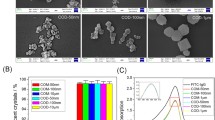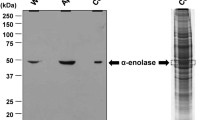Abstract
During an initial phase of kidney stone formation, the internalization of calcium oxalate (CaOx) crystals by renal tubular cells has been thought to occur via endocytosis. However, the precise mechanism of CaOx crystal endocytosis remained unclear. In the present study, MDCK renal tubular cells were pretreated with inhibitors specific to individual endocytic pathways, including nystatin (lipid raft/caveolae-mediated), cytochalasin D (actin-dependent or macropinocytosis), and chlorpromazine (CPZ; clathrin-mediated) before exposure to plain (non-labeled), or fluorescence-labeled CaOx monohydrate (COM) crystals. Quantitative analysis by flow cytometry revealed that pretreatment with nystatin and CPZ slightly decreased the crystal internalization, whereas the cytochalasin D pretreatment caused a marked decrease in crystal uptake. Immunofluorescence study and laser-scanning confocal microscopic examination confirmed that the cytochalasin D-pretreated cells had dramatic decrease of the internalized crystals, whereas the total number of crystals interacted with the cells was unchanged (crystals could adhere but were not internalized). These data have demonstrated for the first time that renal tubular cells endocytose COM crystals mainly via macropinocytosis. These novel findings will be useful for further tracking the endocytosed crystals inside the cells during the course of kidney stone formation.



Similar content being viewed by others
References
Moe, O. W. (2006). Kidney stones: Pathophysiology and medical management. Lancet, 367, 333–344.
Khan, S. R., & Hackett, R. L. (1991). Retention of calcium oxalate crystals in renal tubules. Scanning Microscopy, 5, 707–711.
De Bruijn, W. C., Boeve, E. R., van Run, P. R., van Miert, P. P., de Water, R., Romijn, J. C., et al. (1995). Etiology of calcium oxalate nephrolithiasis in rats. I. Can this be a model for human stone formation? Scanning Microscopy, 9, 103–114.
de Water, R., Noordermeer, C., van der Kwast, T. H., Nizze, H., Boeve, E. R., Kok, D. J., et al. (1999). Calcium oxalate nephrolithiasis: Effect of renal crystal deposition on the cellular composition of the renal interstitium. American Journal of Kidney Diseases, 33, 761–771.
Tsujihata, M. (2008). Mechanism of calcium oxalate renal stone formation and renal tubular cell injury. International Journal of Urology, 15, 115–120.
Lieske, J. C., Swift, H., Martin, T., Patterson, B., & Toback, F. G. (1994). Renal epithelial cells rapidly bind and internalize calcium oxalate monohydrate crystals. Proceedings of the National Academy of Sciences USA, 91, 6987–6991.
Schepers, M. S., Duim, R. A., Asselman, M., Romijn, J. C., Schroder, F. H., & Verkoelen, C. F. (2003). Internalization of calcium oxalate crystals by renal tubular cells: A nephron segment-specific process? Kidney International, 64, 493–500.
Evan, A. P., Lingeman, J. E., Coe, F. L., Parks, J. H., Bledsoe, S. B., Shao, Y., et al. (2003). Randall’s plaque of patients with nephrolithiasis begins in basement membranes of thin loops of Henle. The Journal of Clinical Investigation, 111, 607–616.
Kumar, V., Farell, G., Yu, S., Harrington, S., Fitzpatrick, L., Rzewuska, E., et al. (2006). Cell biology of pathologic renal calcification: Contribution of crystal transcytosis, cell-mediated calcification, and nanoparticles. Journal of Investigative Medicine, 54, 412–424.
Evan, A. P., Coe, F. L., Lingeman, J. E., Shao, Y., Sommer, A. J., Bledsoe, S. B., et al. (2007). Mechanism of formation of human calcium oxalate renal stones on Randall’s plaque. The Anatomical Record (Hoboken), 290, 1315–1323.
Doherty, G. J., & McMahon, H. T. (2009). Mechanisms of endocytosis. Annual Review of Biochemistry, 78, 857–902.
Ivanov, A. I. (2008). Pharmacological inhibition of endocytic pathways: Is it specific enough to be useful? Methods in Molecular Biology, 440, 15–33.
Seto, E. S., Bellen, H. J., & Lloyd, T. E. (2002). When cell biology meets development: Endocytic regulation of signaling pathways. Genes & Development, 16, 1314–1336.
Parton, R. G., & Richards, A. A. (2003). Lipid rafts and caveolae as portals for endocytosis: New insights and common mechanisms. Traffic, 4, 724–738.
Vassilieva, E. V., Gerner-Smidt, K., Ivanov, A. I., & Nusrat, A. (2008). Lipid rafts mediate internalization of beta1-integrin in migrating intestinal epithelial cells. American Journal of Physiology Gastrointestinal and Liver Physiology, 295, G965–G976.
Kerr, M. C., & Teasdale, R. D. (2009). Defining macropinocytosis. Traffic, 10, 364–371.
Sorkin, A. (2004). Cargo recognition during clathrin-mediated endocytosis: A team effort. Current Opinion in Cell Biology, 16, 392–399.
Ros-Baro, A., Lopez-Iglesias, C., Peiro, S., Bellido, D., Palacin, M., Zorzano, A., et al. (2001). Lipid rafts are required for GLUT4 internalization in adipose cells. Proceedings of the National Academy of Sciences USA, 98, 12050–12055.
Peterson, J. R., & Mitchison, T. J. (2002). Small molecules, big impact: A history of chemical inhibitors and the cytoskeleton. Chemistry & Biology, 9, 1275–1285.
Inal, J., Miot, S., & Schifferli, J. A. (2005). The complement inhibitor, CRIT, undergoes clathrin-dependent endocytosis. Experimental Cell Research, 310, 54–65.
Chaiyarit, S., Mungdee, S., & Thongboonkerd, V. (2010). Non-radioactive labelling of calcium oxalate crystals for investigations of crystal-cell interaction and internalization. Analytical Methods, 2, 1536–1541.
Thongboonkerd, V., Semangoen, T., Sinchaikul, S., & Chen, S. T. (2008). Proteomic analysis of calcium oxalate monohydrate crystal-induced cytotoxicity in distal renal tubular cells. Journal of Proteome Research, 7, 4689–4700.
Semangoen, T., Sinchaikul, S., Chen, S. T., & Thongboonkerd, V. (2008). Proteomic analysis of altered proteins in distal renal tubular cells in response to calcium oxalate monohydrate crystal adhesion: Implications for kidney stone disease. Proteomics Clinical Applications, 2, 1099–1109.
Verkoelen, C. F., van der Boom, B. G., Houtsmuller, A. B., Schroder, F. H., & Romijn, J. C. (1998). Increased calcium oxalate monohydrate crystal binding to injured renal tubular epithelial cells in culture. American Journal of Physiology, 274, F958–F965.
Kohjimoto, Y., Ebisuno, S., Tamura, M., & Ohkawa, T. (1996). Interactions between calcium oxalate monohydrate crystals and Madin–Darby canine kidney cells: Endocytosis and cell proliferation. Urological Research, 24, 193–199.
Verkoelen, C. F., & Verhulst, A. (2007). Proposed mechanisms in renal tubular crystal retention. Kidney International, 72, 13–18.
Kok, D. J., & Khan, S. R. (1994). Calcium oxalate nephrolithiasis, a free or fixed particle disease. Kidney International, 46, 847–854.
Lieske, J. C., & Toback, F. G. (1993). Regulation of renal epithelial cell endocytosis of calcium oxalate monohydrate crystals. American Journal of Physiology, 264, F800–F807.
Ebisuno, S., Kohjimoto, Y., Tamura, M., Inagaki, T., & Ohkawa, T. (1997). Histological observations of the adhesion and endocytosis of calcium oxalate crystals in MDCK cells and in rat and human kidney. Urologia Internationalis, 58, 227–231.
Khan, S. R. (1995). Calcium oxalate crystal interaction with renal tubular epithelium, mechanism of crystal adhesion and its impact on stone development. Urological Research, 23, 71–79.
Lieske, J. C., Norris, R., Swift, H., & Toback, F. G. (1997). Adhesion, internalization and metabolism of calcium oxalate monohydrate crystals by renal epithelial cells. Kidney International, 52, 1291–1301.
Hovda, K. E., Guo, C., Austin, R., & McMartin, K. E. (2010). Renal toxicity of ethylene glycol results from internalization of calcium oxalate crystals by proximal tubule cells. Toxicology Letters, 192, 365–372.
Borges, F. T., Michelacci, Y. M., Aguiar, J. A., Dalboni, M. A., Garofalo, A. S., & Schor, N. (2005). Characterization of glycosaminoglycans in tubular epithelial cells: Calcium oxalate and oxalate ions effects. Kidney International, 68, 1630–1642.
Dukes, J. D., Whitley, P., & Chalmers, A. D. (2011). The MDCK variety pack: Choosing the right strain. BMC Cell Biology, 12, 43.
Campos, A. H., & Schor, N. (2000). Mechanisms involved in calcium oxalate endocytosis by Madin–Darby canine kidney cells. Brazilian Journal of Medical and Biological Research, 33, 111–118.
Kohjimoto, Y., Ebisuno, S., Tamura, M., & Ohkawa, T. (1996). Adhesion and endocytosis of calcium oxalate crystals on renal tubular cells. Scanning Microscopy, 10, 459–468.
Racoosin, E. L., & Swanson, J. A. (1993). Macropinosome maturation and fusion with tubular lysosomes in macrophages. Journal of Cell Biology, 121, 1011–1020.
Kerr, M. C., Lindsay, M. R., Luetterforst, R., Hamilton, N., Simpson, F., Parton, R. G., et al. (2006). Visualisation of macropinosome maturation by the recruitment of sorting nexins. Journal of Cell Science, 119, 3967–3980.
Acknowledgments
This study was supported by Office of the Higher Education Commission and Mahidol University under the National Research Universities Initiative, The Thailand Research Funds (RTA5380005, TRG5480005, and TRG5480008), and Faculty of Medicine Siriraj Hospital. KS is supported by the Royal Golden Jubilee PhD Program, whereas VT is also supported by the “Chalermphrakiat” Grant, Faculty of Medicine Siriraj Hospital.
Author information
Authors and Affiliations
Corresponding author
Electronic supplementary material
Below is the link to the electronic supplementary material.
Rights and permissions
About this article
Cite this article
Kanlaya, R., Sintiprungrat, K., Chaiyarit, S. et al. Macropinocytosis is the Major Mechanism for Endocytosis of Calcium Oxalate Crystals into Renal Tubular Cells. Cell Biochem Biophys 67, 1171–1179 (2013). https://doi.org/10.1007/s12013-013-9630-8
Published:
Issue Date:
DOI: https://doi.org/10.1007/s12013-013-9630-8




